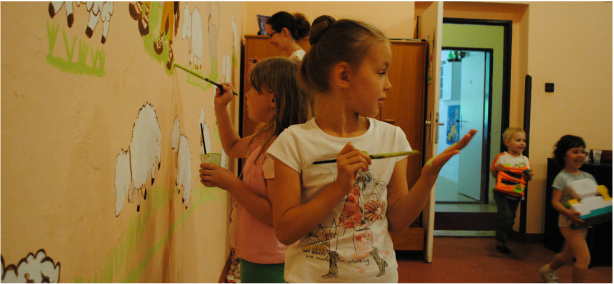|
By Kelly Palmatier, CompassionateKids.com, adapted Volunteering with children is a great way to help them learn about giving back. Children learn valuable skills, such as communication, organization, and team working, while “on the job”. One benefit of volunteering is that children learn about the concerns of the organization they work with, and what need it fills in the community. Consequently, the children also have an opportunity to remember what to be thankful for. It’s important to work side-by-side with your child, since leading by example has been shown to be the most effective form of teaching. Children who see their parents volunteering are much more likely to believe in the value of working to help others. Working side-by-side with your child has many benefits. It is the most effective way to teach your child the value of helping others, ensures that the child’s presence is a help, not a hindrance to the organization’s staff and other volunteers, and while focused on a task together, may foster deep conversations that may not have occurred otherwise. When choosing a volunteer opportunity, it is important to consider the following: 1. Your child’s interests: If your child is clearly interested in a subject, it may be possible to use that interest as a springboard into volunteering: Children who construct a lot of forts or buildings with blocks may enjoy helping out with a safe, simple renovation project. Children who love animals may enjoy helping animal organizations. Children who enjoy clothes and toys can start a clothing and toy drive for poor kids. Children who like baking can provide cookies to a poor orphanage or a home for the elderly. 2. Your interests: It is also important to consider your own interests as your child will emulate your passion and enthusiasm. 3. Your child’s abilities: If your child is very young, it can be challenging to choose a volunteer opportunity that he/she can actually help with. There are opportunities available that even very young children can do with a little parental guidance, such as helping to bag or box items for those in need, or giving flowers, cookies, or hugs to the elderly. 4. Your abilities: Your child will benefit from seeing you work well in your element. For example, if you are especially skilled at home renovations, you may find a community restoration project to work on. This would allow you to share your skills while demonstrating the relevance volunteering has in regards to different careers and interests. 5. Location, frequency, and duration: Consider the basic logistics of any volunteer opportunity. If the opportunity is close by, a commitment to help on a weekly basis may be fine. If it’s farther away, consider helping on a monthly basis. Your child is learning work ethics from this experience, so ensure you arrive on time, and only cancel or reschedule when you truly have valid reasons and can give plenty of notice. The duration of each volunteer session can vary according to the age of the children. Older children may be fine with a few hours or more, but younger children may need sessions to be short, even forty-five minutes. 6. Staff attitude: Most people will appreciate your instilling a volunteer ethic in children at a young age, but some will focus more on the noise level or other potential distractions. It is important to consider the effect others’ attitudes have on your child. If a child feels like a hindrance, volunteering could end up like a chore rather than a joy. The effort put into organizing volunteer opportunities for your children can provide a lifetime of benefit for both the kids involved and for society. Resources for finding volunteer opportunities
Article courtesy of Motivated magazine. Used with permission. Photo by David Katarina via Flickr.
0 Comments
|
Categories
All
Archives
March 2024
LinksFree Children's Stories |


 RSS Feed
RSS Feed
